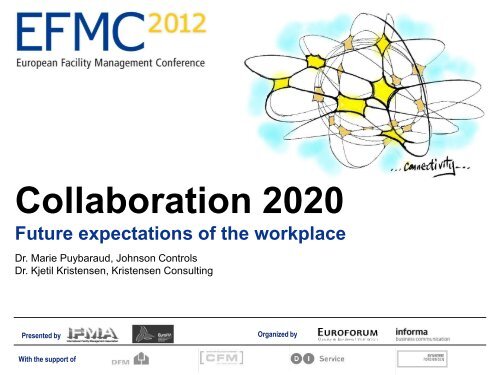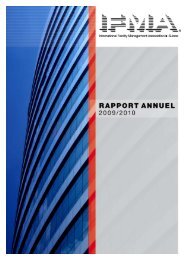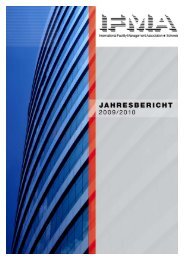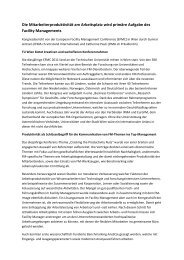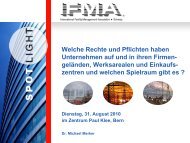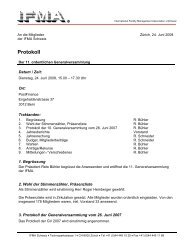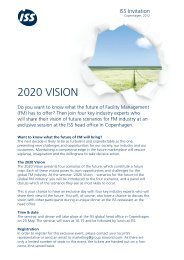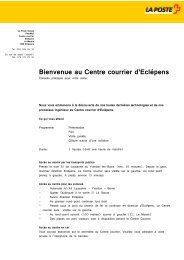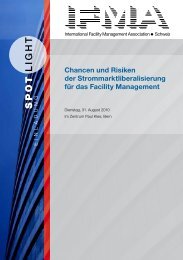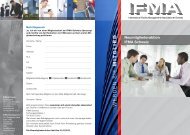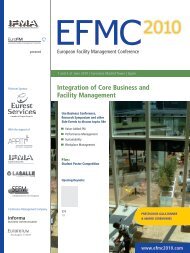Collaboration 2020
Collaboration 2020
Collaboration 2020
Create successful ePaper yourself
Turn your PDF publications into a flip-book with our unique Google optimized e-Paper software.
<strong>Collaboration</strong> <strong>2020</strong><br />
Future expectations of the workplace<br />
Dr. Marie Puybaraud, Johnson Controls<br />
Dr. Kjetil Kristensen, Kristensen Consulting<br />
Presented by<br />
Organized by<br />
With the support of
<strong>Collaboration</strong> <strong>2020</strong>:<br />
Future expectations of<br />
the workplace<br />
1,700+ respondents<br />
26 strategic interviews<br />
5 industry sectors<br />
Life Science, Technology, Industrial,<br />
Oil & Gas and Finance<br />
www.johnsoncontrols.com/globalworkplaceinnovation
<strong>Collaboration</strong> is<br />
complex<br />
<strong>Collaboration</strong> can be<br />
defined as interactions<br />
that enable employees,<br />
customers, suppliers and<br />
partners to:<br />
• Achieve business<br />
objectives<br />
• Make good decisions<br />
• Resolve issues<br />
• Share knowledge<br />
1. When entering the workforce, we<br />
are basically unprepared<br />
2. There appears to be a clear<br />
correlation between how<br />
knowledge-intensive a job is and<br />
the relative amount of time spent of<br />
collaborative activities<br />
3. There is a clear link between<br />
performance and collaboration<br />
4. <strong>Collaboration</strong> is complex<br />
www.johnsoncontrols.com/globalworkplaceinnovation
Methodology<br />
How should companies<br />
position themselves<br />
towards <strong>2020</strong> to take<br />
advantage of<br />
e-technologies and<br />
collaborative practices in<br />
order to boost their<br />
productivity and innovation<br />
capabilities and therefore<br />
create sustainable<br />
competitive advantage in a<br />
networked, global<br />
economy?<br />
Expert<br />
views<br />
Thought<br />
leadership<br />
Qualitative data<br />
Forward<br />
thinking<br />
Final report<br />
User<br />
views<br />
Insight and<br />
perception<br />
Quantitative data<br />
Key<br />
findings<br />
7518a0412<br />
www.johnsoncontrols.com/globalworkplaceinnovation
<strong>Collaboration</strong> <strong>2020</strong>: Future expectations of the workplace<br />
Key insights from the survey<br />
www.johnsoncontrols.com/globalworkplaceinnovation
Top 10 findings<br />
with 1,700+ respondents<br />
1. Customer satisfaction is rated<br />
as the most important gauge of<br />
performance<br />
2. Performance is linked to<br />
collaboration on both a<br />
strategic and an operational<br />
level<br />
3. <strong>Collaboration</strong> is an important<br />
driver of creativity and<br />
innovation<br />
4. The majority of respondents<br />
expect to be using highperformance<br />
project spaces a<br />
lot in <strong>2020</strong><br />
5. E-mail is still popular , and<br />
touch-based mobile<br />
technologies have a strong<br />
value proposition<br />
6. The use of video communication<br />
and real-time collaboration tools<br />
will increase substantially<br />
7. The majority of professionals do<br />
not like blogging and<br />
micro blogging<br />
8. Supporting collaboration<br />
requires more than technology<br />
9. Advanced technologies not<br />
in current use have an<br />
interesting future value<br />
proposition<br />
10. Working alone on isolated tasks<br />
will remain an important part of<br />
professionals’ lives<br />
www.johnsoncontrols.com/globalworkplaceinnovation
Supporting collaboration<br />
requires more than technology<br />
• Training (27.2% strongly<br />
agree, 37.9 agree)<br />
• Knowledge-sharing tools<br />
(22.5% strongly agree, 41.8%<br />
agree)<br />
• IT systems (15.9% strongly<br />
agree, 43.8% agree)<br />
• Management and leadership<br />
principles (12.5% strongly<br />
agree, 43.8% agree)<br />
• Workplace design (10.1%<br />
strongly agree, 43.0% agree)<br />
Management and<br />
leadership principles<br />
IT systems<br />
HR practices and policies<br />
FM system and services<br />
Web 2.0 applications<br />
Workplace design<br />
Space management<br />
solutions<br />
Training<br />
Knowledge sharing tools<br />
0% 20% 40% 60% 80% 100%<br />
Strongly Agree<br />
Agree<br />
Neither agree or disagree<br />
Disagree<br />
Strongly Disagree<br />
I don't know<br />
7521a0412
These workplace technologies and<br />
solutions are covered in the survey<br />
Current, standard tools<br />
E-mail, desk phone, smartphone, mobile / cell phone, instant messaging, workspaces and shared<br />
drives, touch-screen computing device (iPad, reader), convertible tablet PC<br />
Real-time collaboration tools and workplace solutions<br />
Traditional meeting facility, informal meetings spaces / breakout spaces, dedicated collaboration room,<br />
web conferencing, video conferencing / 2D TelePresence, high-performance project spaces<br />
Blue sky technologies<br />
3D TelePresence, knowledge-brokering services and agents, gesture-based computing environments,<br />
automated translation software, speech-to-text-software, text-to-speech-software, 3D visualization,<br />
wearable computing (intelligent clothes or similar), augmented reality environment (AR), interactive<br />
business games, virtual worlds such as Second Life or similar<br />
All results analyzed per region, job level, collaboration maturity level ++<br />
www.johnsoncontrols.com/globalworkplaceinnovation
Video communication and<br />
real-time collaboration tools<br />
3D telepresence<br />
N/A<br />
N/A<br />
More than 40%<br />
report high<br />
expected use of<br />
3D TelePresence<br />
Web conferencing<br />
Video conferencing<br />
High<br />
High<br />
use<br />
use <strong>2020</strong><br />
<strong>2020</strong><br />
(expected)<br />
(expected)<br />
High use 2010<br />
High Currently use like 2010<br />
Currently like<br />
0 20 40 60 80
Increased need for highperformance<br />
project spaces<br />
towards <strong>2020</strong><br />
60%<br />
50%<br />
40%<br />
30%<br />
20%<br />
10%<br />
The majority of<br />
respondents<br />
(51.8%) expect<br />
to be using highperformance<br />
High use 2010<br />
project spaces a<br />
High use <strong>2020</strong><br />
lot in <strong>2020</strong>, more<br />
than any other<br />
type of facility.<br />
0%<br />
Traditional meeting<br />
facilities<br />
Informal meeting<br />
spaces or breakout<br />
spaces<br />
High-performance<br />
project spaces<br />
Dedicated<br />
collaboration rooms<br />
High use <strong>2020</strong> (expected)<br />
High use 2010
There appears to be a<br />
pronounced tendency for<br />
male respondents to like new,<br />
visible technologies that include<br />
hardware such as:<br />
Technology-rich, high<br />
performance project spaces<br />
(42.9% vs. 39.8% for females),<br />
3D TelePresence<br />
(33.7% vs. 27.7% for females),<br />
Wearable computing<br />
(32.8% vs. 20.5% for females)<br />
Convertible tablet PC<br />
(48.2% vs. 41.3% for females).<br />
Male vs female
Mass collaboration<br />
Mass collaboration is seen as having a significant impact on the<br />
market presence of organisations (56% agree to strongly agree),<br />
with America being the most enthusiastic, followed by APAC and<br />
EMEA. Middle managers and executives are stronger believers<br />
in the impact that mass collaboration could have on their<br />
organisations in comparison to other team members (60.5%<br />
against 53.6%).
Touch surfaces<br />
62% of our respondents predict extensive use of touch-only<br />
computing devices (i.e. iPads) in <strong>2020</strong> compared to only 16%<br />
now.
Virtual worlds<br />
65% of our respondents do not consider the use of virtual<br />
worlds, such as Second Life, as a suitable solution to boost<br />
collaboration at work today and only 26% would consider a<br />
high use of them by <strong>2020</strong>.
Robot pet<br />
33.2% of senior and executive managers would consider<br />
having a robot pet to keep them company when working<br />
long hours.
Managing collaboration is more about promoting and<br />
enabling the benefits of collaboration than it is about<br />
managing the costs.<br />
But how?
<strong>Collaboration</strong> <strong>2020</strong>: Future expectations of the workplace<br />
Practical implications<br />
workplace / collaboration<br />
www.johnsoncontrols.com/globalworkplaceinnovation
Succeeding with collaboration at a<br />
level where it represents a<br />
competitive advantage requires a<br />
broad approach<br />
• The function or role of the office<br />
and the physical workplace is<br />
rapidly becoming one of supporting<br />
collaboration<br />
• There is a gap between current and<br />
projected needs of knowledge<br />
workers and workplace<br />
infrastructure<br />
• The use of video communication<br />
and real-time collaboration tools<br />
will increase substantially<br />
www.johnsoncontrols.com/globalworkplaceinnovation
The main function of the office is<br />
rapidly becoming one of supporting<br />
collaboration<br />
Implications<br />
Workplace<br />
• Realign service offerings<br />
• New service concepts<br />
<strong>Collaboration</strong><br />
• Paying lip service is not enough<br />
• Disconnect between high-level<br />
collaboration objectives and day-to-day<br />
operations<br />
www.johnsoncontrols.com/globalworkplaceinnovation
There is a gap between current and<br />
projected needs of knowledge<br />
workers and workplace<br />
infrastructure<br />
Implications<br />
Workplace<br />
• A shift towards bespoke user experience<br />
• Unplugging FM<br />
<strong>Collaboration</strong><br />
• Service conceptualisation<br />
• Collaborative engagement through<br />
awareness and training<br />
www.johnsoncontrols.com/globalworkplaceinnovation
The use of video communication<br />
and real-time collaboration tools<br />
will increase substantially<br />
Implications<br />
Workplace<br />
• Distributed collaboration infrastructures<br />
distinctively different from current<br />
solutions<br />
• Retrofitting programmes<br />
• Multiple disciplines in the decisionmaking<br />
process<br />
<strong>Collaboration</strong><br />
• Beyond technology solutions<br />
• Unified helpdesk service functions<br />
www.johnsoncontrols.com/globalworkplaceinnovation
7 Recommendations<br />
1.Leadership<br />
2.Training<br />
3.Technology<br />
5.Knowledge<br />
4.Workplace<br />
7.Services<br />
6.Immersive<br />
Solutions
1.Leadership<br />
Strong<br />
Facilitating and fostering a<br />
constraint-free environment<br />
7.Services<br />
6.Immersive<br />
Solutions<br />
1.Leadership<br />
2.Training<br />
3.Technology<br />
5.Knowledge<br />
4.Workplace
2.Training<br />
To raise the level of engagement<br />
7.Services<br />
6.Immersive<br />
Solutions<br />
2.Training<br />
5.Knowledge<br />
4.Workplace<br />
1.Leadership<br />
3.Technology
3.Technologies<br />
<strong>Collaboration</strong> engagement “kit”<br />
7.Services<br />
6.Immersive<br />
Solutions<br />
3.Technology<br />
5.Knowledge<br />
4.Workplace<br />
1.Leadership<br />
2.Training
4.Workplace<br />
Provision of the right working<br />
environment<br />
7.Services<br />
4.Workplace<br />
5.Knowledge<br />
6.Immersive<br />
Solutions<br />
1.Leadership<br />
2.Training<br />
3.Technology
5.Knowledge<br />
Fast and easy access to<br />
a knowledge platform<br />
5.Knowledge<br />
7.Services<br />
6.Immersive<br />
Solutions<br />
1.Leadership<br />
2.Training<br />
3.Technology<br />
4.Workplace
6.Immersive<br />
Solutions<br />
Touch-based and<br />
immersive technologies<br />
6.Immersive<br />
Solutions<br />
7.Services<br />
5.Knowledge<br />
4.Workplace<br />
1.Leadership<br />
2.Training<br />
3.Technology
7.Services<br />
Smart facilities<br />
management services<br />
7.Services<br />
1.Leadership<br />
2.Training<br />
3.Technology<br />
5.Knowledge<br />
4.Workplace<br />
6.Immersive<br />
Solutions
1.Leadership<br />
2.Training<br />
3.Technology<br />
5.Knowledge<br />
4.Workplace<br />
7.Services<br />
6.Immersive<br />
Solutions
“My business owner<br />
could be more into<br />
technology. It is an<br />
arm-twisting session to<br />
get him to do anything<br />
new with technology.”<br />
An anonymous knowledge worker<br />
Presented by<br />
Organized by<br />
With the support of
marie.c.puybaraud@jci.com<br />
kc@kristensenconsulting.com<br />
www.johnsoncontrols.com/globalworkplaceinnovation<br />
www.johnsoncontrols.com/globalworkplaceinnovation


